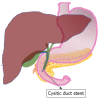Endoscopic ultrasound guided gallbladder drainage - is it ready for prime time?
- PMID: 30568842
- PMCID: PMC6288492
- DOI: 10.4292/wjgpt.v9.i6.47
Endoscopic ultrasound guided gallbladder drainage - is it ready for prime time?
Abstract
Management of acute cholecystitis includes initial stabilization and antibiotics. However, the most definitive treatment is cholecystectomy. A small percentage of patients who are not suitable for surgery due to the severity of cholecystitis or comorbidities will require a temporary measure as a bridge to surgery or permanent nonoperative management to decrease the mortality and morbidity. Most of these patients who require conservative management were managed with percutaneous transhepatic cholecystostomy or trans-papillary drainage of gallbladder drainage with cystic duct stenting through endoscopic retrograde cholangiopancreaticography (ERCP). Although, these conservative measures are effective, they can cause significant discomfort to the patients especially if used as a long-term measure. In view of this, there is a need for further minimally invasive procedures, which is safe, effective and comfortable to patients. Endoscopic ultrasound (EUS) guided gallbladder drainage is a novel method of gallbladder drainage first described in 2007[1]. Over the last decade, EUS guided gallbladder drainage has evolved as an effective alternative to percutaneous cholecystostomy and trans-papillary gallbladder drainage. Our goal is to review available literature regarding the scope of EUS guided gallbladder drainage as a viable alternative to percutaneous cholecystostomy or cystic duct stenting through ERCP among patients who are not suitable for cholecystectomy.
Keywords: Acute acalculous cholecystitis; Acute cholecystitis; Endoscopic ultrasound guided gallbladder drainage; Percutaneous cholecystostomy; Trans-papillary gallbladder drainage.
Conflict of interest statement
Conflict-of-interest statement: None of the authors have any conflicts of interest.
Figures
References
-
- Baron TH, Topazian MD. Endoscopic transduodenal drainage of the gallbladder: implications for endoluminal treatment of gallbladder disease. Gastrointest Endosc. 2007;65:735–737. - PubMed
-
- Katabathina VS, Zafar AM, Suri R. Clinical Presentation, Imaging, and Management of Acute Cholecystitis. Tech Vasc Interv Radiol. 2015;18:256–265. - PubMed
-
- Friedman GD. Natural history of asymptomatic and symptomatic gallstones. Am J Surg. 1993;165:399–404. - PubMed
-
- Kimura Y, Takada T, Strasberg SM, Pitt HA, Gouma DJ, Garden OJ, Büchler MW, Windsor JA, Mayumi T, Yoshida M, et al. TG13 current terminology, etiology, and epidemiology of acute cholangitis and cholecystitis. J Hepatobiliary Pancreat Sci. 2013;20:8–23. - PubMed
-
- Huffman JL, Schenker S. Acute acalculous cholecystitis: a review. Clin Gastroenterol Hepatol. 2010;8:15–22. - PubMed




